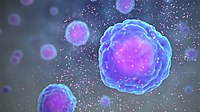
Photo from wikipedia
Novel experimental approaches such as fate-mapping and single-cell analysis have brought fresh insight into monocyte development and function over the past decade and helped redefine the monocyte field. Monocytes are… Click to show full abstract
Novel experimental approaches such as fate-mapping and single-cell analysis have brought fresh insight into monocyte development and function over the past decade and helped redefine the monocyte field. Monocytes are now known to consist of multiple subsets generated through distinct developmental pathways with diverse functional specializations. Their fates under homeostatic conditions include the accumulation in peripheral reservoirs and the engraftment into certain resident macrophage pools. Under pathological conditions, monocytes acquire inflammatory effector functions, but can also develop regulatory properties essential for tissue repair. Importantly, monocytes recruited during inflammation are often functionally distinct from resident macrophages or conventional dendritic cells. Here we outline emerging concepts in monocyte heterogeneity, emergency monopoiesis, and trained immunity and discuss how these bring new perspectives to monocyte research.
Journal Title: Immunity
Year Published: 2018
Link to full text (if available)
Share on Social Media: Sign Up to like & get
recommendations!